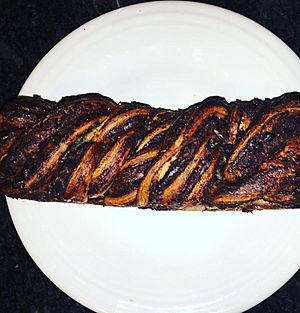Babka facts for kids

A photo of a Chocolate Babka from Breads Bakery in New York City.
|
|
| Alternative names | Krantz cake |
|---|---|
| Type | Bread or cake |
| Place of origin | Jewish communities in Eastern Europe |
| Variations | Chocolate babka, cinnamon babka, apple babka, sweet cheese babka, cinnamon raisin babka |
A babka is a sweet braided bread or cake. It first came from Jewish communities in Poland and Ukraine. Today, it is very popular in Israel and among Jewish people living in other countries. Babka is made from a special dough that uses yeast. This dough is rolled flat and filled with tasty things like chocolate, cinnamon, fruit, or cheese. Then, it is rolled up, braided (like hair), and baked until golden. In Israel, it's often just called a yeast cake (עוגת שמרים).
Contents
The Story of Babka
Babka started in Jewish communities in Eastern Europe in the early 1800s. Back then, bakers would often have extra dough from making challah (a braided bread). They would roll this extra dough with fruit jam or cinnamon. Then they baked it as a loaf alongside the challah. Chocolate was not used at first because it was not easy to find. Chocolate babka probably became popular in America in the mid-1900s.
The name "babka" might come from a type of Easter cake popular in Poland and western Ukraine. This cake is called baba or babka. In Polish, babka means "grandmother." It is similar to the Yiddish word bubbe.
Even though the Polish and Ukrainian babka share the same name as the Jewish babka, they look and are made very differently. The Eastern European babka gets its name from its tall, round shape. It is baked in a special pan that makes it look like a grandmother's skirt. But the babka brought to places like New York by people moving there looks different. It has rich, yeasted dough strands woven together and baked in a loaf pan.
For a long time, most people outside the Polish Jewish community did not know about babka. Then, in the late 1950s, bakeries in Israel and the United States began to sell it. Besides chocolate, other fillings became popular. These included poppy seeds, almond paste, and cheese. Some bakers also started adding a crunchy topping called streusel.
Babka's Rise in Popularity
In the 2010s, babka became much more popular across the United States. This was especially true in New York City. A famous Israeli bakery from Tel Aviv, called Breads Bakery, opened a shop there. They started selling their babka with classic fillings like cinnamon. They also offered new fillings like Nutella, apple, and cheesecake. They even made a savory (not sweet) version with za'atar spice and feta cheese. Their chocolate babka became very well known.
Because of this new popularity, babka is now enjoyed by many people, both Jewish and non-Jewish. You can find many new and interesting babka flavors. Some include buffalo chicken, rainbow, everything bagel, and cookie butter. Babka is also used in other dishes. You might find babka french toast, babka cheesecake, or even babka ice cream.
Babka is now available in many grocery stores across the U.S. For example, Trader Joe's sells its own chocolate babka, which is made in Brooklyn.
How Babka is Made
Babka is made from a special dough. This dough can be "enriched," meaning it has extra butter and eggs, like challah dough. Or it can be "laminated," meaning it's folded many times with butter, like croissant dough.
The dough is rolled out flat. Then, it's spread with sweet fillings. Popular choices include chocolate, cinnamon sugar, apples, sweet cheese, Nutella, mohn (a sweet poppy seed paste), or raisins. After filling, the dough is rolled up and braided. It can be an "open" braid, where you see the filling, or a "closed" braid.
After baking, a sweet sugar syrup is often poured over the babka. This helps keep it fresh and makes it extra moist. Sometimes, a crunchy streusel topping is added too.
Different Kinds of Babka
American Style Babka
American style babka is usually made with a dough similar to challah. It often has a streusel topping, poppy seeds, or a crumb topping.
Israeli Style Babka
Israeli style babka (עוגת שמרים) uses a laminated dough. This dough is rich with butter and is folded and rolled many times. This creates many thin layers, much like the dough for Israeli style rugelach or croissants.
Israeli babka comes with more types of fillings and shapes. It is most often baked in a loaf pan. But it can also be made into individual babkas, a pie shape, a ring, or braided twists. The most popular fillings are chocolate, often made with Israeli chocolate spread like Haschahar Ha'ole. Other popular fillings include mohn (sweet poppy seed paste) and sweet cheese, usually made with gvina levana. Israeli babka rarely has a streusel topping.
While usually sweet, savory (not sweet) versions are also popular in Israel. These often contain labneh (a type of yogurt cheese) and za'atar spice. Sometimes, babka is baked as "roses," which are individual pastries shaped like a rose. They can also be made with a closed braid, instead of the more common open braid.
Kokosh
A similar cake called kokosh is also popular in Jewish bakeries. Kokosh also comes in chocolate and cinnamon flavors. However, it is flatter and longer than babka. It is not twisted or topped with streusel. These types of cakes are often called wikit:couronnes when baked in loaf pans, rather than babkas. Kokosh has become popular in North American cities with many Jewish people. These cities include Montreal, New York, Chicago, Miami, and Toronto.
See also
 In Spanish: Babka para niños
In Spanish: Babka para niños


